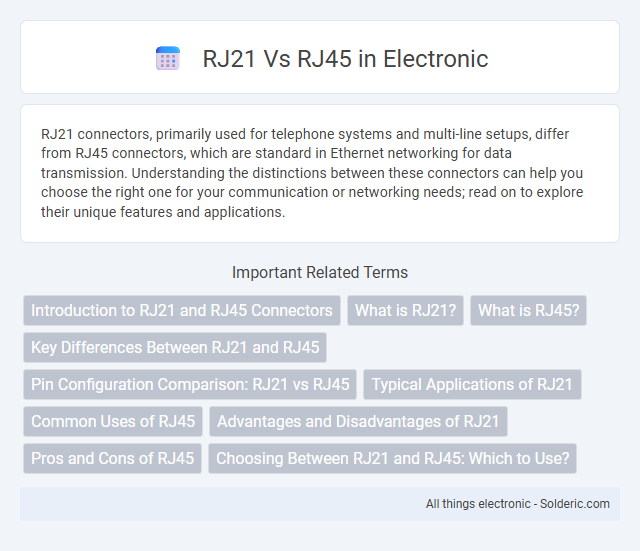RJ21 connectors, primarily used for telephone systems and multi-line setups, differ from RJ45 connectors, which are standard in Ethernet networking for data transmission. Understanding the distinctions between these connectors can help you choose the right one for your communication or networking needs; read on to explore their unique features and applications.
Comparison Table
| Feature | RJ21 | RJ45 |
|---|---|---|
| Connector Type | 25-pair Amphenol connector | 8-pin 8P8C modular connector |
| Common Use | Telephony, structured cabling, bulk cable terminations | Ethernet networking, telephone, data connections |
| Number of Pins/Wires | 50 positions, 25 pairs | 8 positions, 8 wires |
| Cable Type | 25-pair twisted pair cable | Cat5, Cat5e, Cat6 twisted pair cables |
| Max Data Speed | Dependent on cable, typically voice and low-speed data | Up to 10 Gbps (with Cat6a/Cat7) |
| Typical Application | Patch panels, telephone systems, main distribution frames | LANs, internet connections, computer networking |
| Size & Form Factor | Larger bulk connector | Smaller, modular and user-friendly |
| Installation Complexity | Requires specialized tools for crimping | Simple plug-and-play, easy termination |
Introduction to RJ21 and RJ45 Connectors
RJ21 connectors, often called telco connectors, are designed for high-density telecommunications and networking applications, supporting up to 25 pairs of wires in a single connector. RJ45 connectors are widely used for Ethernet networking, featuring an 8-position, 8-contact (8P8C) modular plug that facilitates standard network cabling for data transmission. The RJ21 is typically employed in central office wiring and patch panels, whereas RJ45 dominates local area network (LAN) connections due to its compatibility with twisted-pair Ethernet cables.
What is RJ21?
RJ21 is a telecommunications interface that uses a 25-pair cable with a 50-pin connector, commonly used for high-density voice or data applications. Unlike RJ45, which supports a maximum of 8 wires and is typical for Ethernet connections, RJ21 can handle multiple phone lines or channels through a single connector, making it ideal for PBX systems and telecom infrastructure. Your network or telephony setup benefits from RJ21's compact and organized cabling when managing numerous simultaneous connections.
What is RJ45?
RJ45 is a standardized connector commonly used for Ethernet networking, designed to terminate twisted pair cables such as Cat5, Cat5e, Cat6, and Cat6a. It features eight pins arranged in a single row, enabling data transmission through four twisted pairs of wires ideal for high-speed Internet and local area networks (LANs). Your network setup likely relies on RJ45 connectors for reliable communication and connectivity between devices.
Key Differences Between RJ21 and RJ45
RJ21 connectors, often used in telephony and larger multi-line patch panels, support up to 25 pairs of wires, making them ideal for high-density cabling applications in telecommunications infrastructure. RJ45 connectors are common in Ethernet networking, designed for 8-pin connections, supporting data transfer speeds in LAN environments such as 10/100/1000 Mbps networks. Understanding the key differences between RJ21's multi-pair capacity and RJ45's single-line Ethernet focus can optimize Your network setup depending on whether you need bulk voice connections or high-speed data transmission.
Pin Configuration Comparison: RJ21 vs RJ45
RJ21 connectors utilize a 50-pin configuration designed to accommodate multiple telephone lines or circuits in a single interface, commonly used in telephony and patch panels. RJ45 connectors feature an 8-pin configuration, primarily used for Ethernet networking with standard T568A or T568B wiring schemes supporting single data channels. The RJ21's higher pin count allows for aggregated multi-line connectivity, while RJ45's simpler pin layout optimizes compatibility with network devices and structured cabling systems.
Typical Applications of RJ21
RJ21 connectors are commonly used in telecommunications and data networking environments, specifically for bulk cable terminations such as telephone company wiring and PBX systems. They facilitate the connection of multiple phone lines or data channels through a single interface, often employed in structured cabling and network patch panels. Your infrastructure benefits from RJ21's ability to handle high-density cabling, making it ideal for enterprise telephony and multi-line communication setups.
Common Uses of RJ45
RJ45 connectors are predominantly used in Ethernet networking for connecting computers, routers, and switches within local area networks (LANs). They support data transmission speeds ranging from 10 Mbps to 10 Gbps, making them essential for modern high-speed internet access and network infrastructure. Your network devices commonly rely on RJ45 for reliable wired connections and seamless communication across various digital platforms.
Advantages and Disadvantages of RJ21
RJ21 connectors provide high-density connectivity by supporting up to 25 pairs of wires in a single modular plug, making them ideal for telecommunication applications and patch panels requiring multiple simultaneous connections. Their advantages include space-saving design, simplified cable management, and reduced installation time compared to multiple RJ45 connectors; however, disadvantages involve limited flexibility as RJ21 is primarily used for telephone and legacy systems rather than Ethernet networks, and the connectors can be bulkier and more complex to terminate than individual RJ45 plugs. RJ21's suitability declines in modern networking environments where RJ45 dominates due to widespread support for Ethernet speeds, ease of replacement, and compatibility with network devices.
Pros and Cons of RJ45
RJ45 connectors offer high-speed data transmission and are widely used in Ethernet networking, making them ideal for home and office internet connections. Their design supports up to 8 wires, enabling better performance and compatibility with modern network equipment, but they require proper crimping tools and skill for installation. Your network setup benefits from RJ45's ease of use and reliability, though RJ21 may be preferable in telecom environments needing multiple simultaneous connections.
Choosing Between RJ21 and RJ45: Which to Use?
Choosing between RJ21 and RJ45 depends on the scale and purpose of your network installation. RJ21 connectors, also known as Telco connectors, support multiple lines (up to 25 pairs) and are ideal for high-density telecommunication systems or large PBX setups. RJ45 connectors, commonly used for Ethernet cables, suit standard LAN networks and provide straightforward, single-line connections for data and voice transmission.
RJ21 vs RJ45 Infographic

 solderic.com
solderic.com